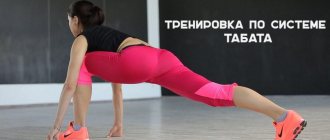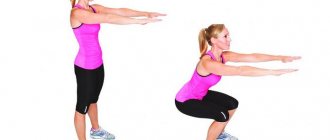Squats are a versatile exercise that can be performed by both men and women. It does not require any additional equipment or inventory. The exercise will help women tighten and increase the volume of their desired buttocks, and men will pump up their legs. But it also works the abdominal muscles and strengthens the back muscles. By regularly performing a set of squats, you can strengthen the muscles of your legs and buttocks, improve your posture, get rid of back pain, burn excess fat, strengthen your cardiovascular system, and increase endurance.
With this simple program, anyone, regardless of age, gender, or fitness level, can do 200 squats in just 30 days! All you need is desire, a good mood and just 20 minutes of free time a day. This set of squats is performed without weights, so you don't need any equipment.
Squat technique
To achieve maximum effect, the exercise must be performed correctly. Otherwise, it may lead to injury and pain. Therefore, a beginner first needs to become familiar with the technique of doing squats:
- Before you start the exercise, you need to stretch your whole body well. To do this, do joint gymnastics: circular rotations with your head and arms, bending your torso forward, backward and to the sides, turning your body, jumping and running in place. Warm-up should last at least 10-15 minutes.
- Now that your whole body is warmed up, you can begin your workout. Stand straight, place your feet shoulder-width apart.
- Raise your arms forward and squat until parallel to the floor. The back should be straight and the abs tense.
- Stand up, tensing your buttock muscles, placing emphasis on your heel.
- Return to the starting position.
- Do this 50 times. Add 5-6 repetitions every day.
Consider a twice-weekly squat training program.
On Mondays - we do an easy workout that is done in conjunction with deadlifts. The first exercise is a basic deadlift, followed by a light squat. Thursdays - We do a core squat workout followed by a light deadlift workout.
Week 1
Monday:
- Deadlift (Core Workout)
- Squat: 40-45% in 3-4 sets of 5-6 reps (Easy workout)
Thursday:
- Squat: 50-55% in 4-5 sets of 5-6 reps (Main training)
- Deadlift (Easy Workout)
Auxiliary exercises:
- Standing bends
- Pause Squat
Week 2
Monday:
- Squat: 40-45% in 3-4 sets of 5-6 reps (Main training)
- Deadlift (Easy Workout)
Thursday:
- Squat: 60-75% in 5-6 sets of 3-5 reps (Main training)
- Deadlift (Easy Workout)
Auxiliary exercises:
- Standing bends
- Front Squat
Week 3
Monday:
- Deadlift (Core Workout)
- Squat: 40-45% in 3-4 sets of 5-6 reps (Easy workout)
Thursday:
- Squat: 80-90% in 3-4 sets of 2-3 reps (Main training)
- Deadlift (Easy Workout)
Auxiliary exercises:
- Standing bends
- Half squats
Features of foot placement
There are different leg positions that focus on different muscle groups. Thus, it is better for men to squat with a narrow leg stance, focusing on the quadriceps (front of the thigh). And for women, it is better to place their feet wider than their shoulders, turning their toes, thereby transferring the load to the gluteus maximus and adductor muscles of the thigh. This position of the legs is called plie. In order for all muscle groups to develop evenly, you can change the position of your legs.
Those who have already mastered squats can use weights to make the task more difficult and increase the load on the muscles. You can use dumbbells, a kettlebell or a barbell as a weighting agent, and if you work out at home, you can take bottles of water or sand, a mop or anything else at hand.
2 Week Squat Program: Ideal Figure
This squat program is designed for 2 weeks of daily effective training. You don't need any special clothes, a gym, or any equipment.
These 10 exercises must be repeated 10 times, so the workout will take you no more than 10 minutes.
The squat program includes a set of exercises that will help effectively work the muscles of your legs and buttocks.
Squat at home in front of the TV, during a break at the office or between classes at the university - and in just 2 weeks you will see amazing results!
What muscles are developed with squats?
What muscles are developed with squats?
Hips: quadriceps and hamstrings, adductors.
Buttock muscles: gluteus maximus, medius and minimus.
Back: spinal column extensors – keep the back straight.
Calf muscles: gastrocnemius, tibialis and soleus.
Different forms of squats allow you to focus on different areas. The wider the legs are placed, the more the adductor muscles of the thighs (inner thigh) develop. The stronger the forward bend, the stronger the development of the hamstrings and buttocks. And the less the body tilts forward, the stronger the quadriceps develop.
Bodyweight squats: video
How to do bodyweight squats. Technique
- Stand shoulder-width apart. Keep your arms in front of you or along your body, knees slightly bent. Keep your back straight. This will be the starting position.
- Squat down until your thighs are parallel to the floor. Stretch your arms forward. In movement, the body leans forward and the pelvis moves back. As you squat, take a breath.
- Rise to the starting position with your arms down. As you rise, exhale.
- Repeat the movement 20 times with 1 minute rest for three sets.
How to do bodyweight squats. Technique
Application of the exercise
For whom . To all aspiring men and women.
When . Bodyweight squats are best performed at the beginning or end of a leg workout. After squats, do leg curls in a lying machine and leg straightening in a machine.
How many . The exercise should be done in 3 sets of 15-20 repetitions.
How to build a workout with squats?
They begin to squat with their own weight, gradually adding very little weight at a time. Increase weight without compromising exercise technique. It is necessary to increase the weight of the weights, otherwise the muscles will not grow.
The load can be increased in two ways:
- increasing the number of repetitions in the approach,
- increasing working weight.
When gaining muscle mass, you can increase to 12 repetitions in one set with a new weight, and then increase the weight again. A training diary, which records the weight on the equipment, the number of repetitions and approaches, will help you not get confused in the numbers and make systematic progress.
A squat is not just the classic knee bend that you were taught in gym class. This is one of the most technically difficult exercises to perform. Don't get upset or worry too much if you can't do everything right the first time. Without sports equipment, the risk of injury is negligible, and the body just needs to get used to the new movements. And, perhaps most importantly, if you have health problems, never start strength training without consulting your doctor.
Varieties of squats
There are several types of squats that allow you to get rid of extra pounds. However, beginners should first of all become familiar with the classical method. It is as follows:
- you need to place your feet shoulder-width apart;
- your back should be kept straight;
- keep your head straight (in the same plane as your back);
- Slowly squat down and fix your body at the lowest point for 5 seconds;
- breathe correctly - descent - inhale, ascent - exhale
Top 7 best drugs for weight loss
| Name | Price |
| Black Latte for weight loss | 99 rub. |
| NATURAL Fit Calorie Blocker Powder | 990 rub. |
| Purple tea "Chang-Shu" | 499 rub. |
| Fat burning drops “Honey Spas” | 1980 rub. 99 rub. (until 02/12/2021) |
| Detox cocktail for weight loss | 147 rub. |
| Lipocarnit for weight loss | 990 rub. |
| Reduslim weight loss product | 149 rub. |
Views: 1,108
Are squats bad for your knees?
If a person does not have serious problems with the knee joints initially, then squats are completely harmless. But provided that they are performed correctly (see below - squat technique). Moreover, squats, performed correctly, significantly improve the condition of the knee joints, as there is a balance in the flexibility of the muscles that flex and extend the legs at the knees.
Note! All squats with additional weight require approval from your doctor if you have problems with the spine and joints.
How are men's squats different from women's?
In squats, men try to load the quadriceps femoris (quadriceps muscle, front surface of the thigh), and women try to load the buttocks and biceps femoris (back surface of the thigh). The quadriceps grows quickly, visually enlarges the legs and does not create a feminine figure. It already works in many exercises, and the girl does not need to additionally load this area. The task of women is to minimize the load on the front surface of the thighs.
Therefore, the technique of performing squats greatly depends on the chosen accents. The smallest details that seem insignificant to beginners can make your feet look massive. Only by knowing how to properly do classic squats for the buttocks at home will you not ruin your shape.
Features of an effective female squat:
- maximum stretching of the gluteal muscles by moving the pelvis back and deep squatting;
- minimizing the load on the quadriceps and increasing the load on the buttocks, biceps and hip adductors (inner thigh) by placing your feet slightly wider than shoulder-width apart.
The exercise also involves the calf muscles, long back muscles and abdominal muscles. They allow you to do hard work, but quickly adapt to the load. You can constantly stimulate hypertrophy only by increasing the volume of work and weights. That’s why everyone is so interested in how many times and how to squat in order to lose weight and pump up your buttocks at home without exercise equipment.
Squat technique. The most important points.
Feet position: shoulder width or wider. The feet are slightly spread apart.
Start of squats: you need to start a squat by tensing your lower back and moving your pelvis back, slightly tilting your body forward, only after that you can begin to bend your knees.
Lower back: necessarily arched and tense. Never squat with a rounded and relaxed lower back! Do not go lower in squats if your lower back begins to round. See illustration: on the left is correct, on the right is incorrect.
Correct and incorrect lower back position in squats
Knees: It is advisable not to extend beyond the imaginary vertical plane extending from the tips of the toes. This condition is easy to comply with if you move your pelvis back and tilt your body forward.
Breathing: Always take a deep breath when bending your legs, and exhale when extending your legs.
Hand work: hands can be held in front of the chest in a lock, raised forward with each squat, raised up with each squat, placed behind the head.
Shoes: if you have flat feet, be sure to squat only in shoes with orthopedic insoles. At the same time, you should actively strengthen the muscles and ligaments of the foot with the help of special gymnastics for flat feet.










